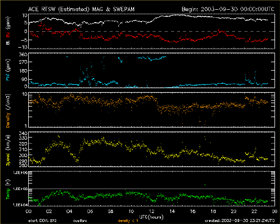



|
Magnetosphere You probably already know that the earth has a magnetic field. You may not realize this field stretches way out into space—at least 37,000 miles (60,000 kilometers)—to form a protective bubble known as the magnetosphere. The magnetosphere is important because it shields us from interplanetary space weather. Charged particles cannot easily cross the lines of a magnetic field. The result is that most of the particles in the incoming solar wind are deflected around the earth by the earth’s magnetic field. However, charged particles are not the only component of the solar wind. The solar wind also carries with it interplanetary magnetic field, or IMF, which is a magnetic field from the sun. The IMF can influence solar weather by disrupting the earth’s magnetosphere. How? The earth’s magnetic field and the IMF connect at the polar caps, and it’s here that energy and particles can and do enter the magnetosphere. If the incoming IMF points south, its interconnection with the earth’s magnetic field becomes especially strong. The effect is like widening a hole—suddenly more energy and particles enter the magnetosphere. Auroras intensify, and geomagnetic storms become likely. For this reason, scientists pay careful attention to not only the strength but also the orientation of incoming magnetic fields from the sun. South-pointing magnetic fields can spell trouble, while north-pointing fields usually coincide with calmer conditions. Magnetic Field Plasma from ACE Satellite Look for south-pointing magnetic fields using live data.
|
|
|
© Exploratorium

